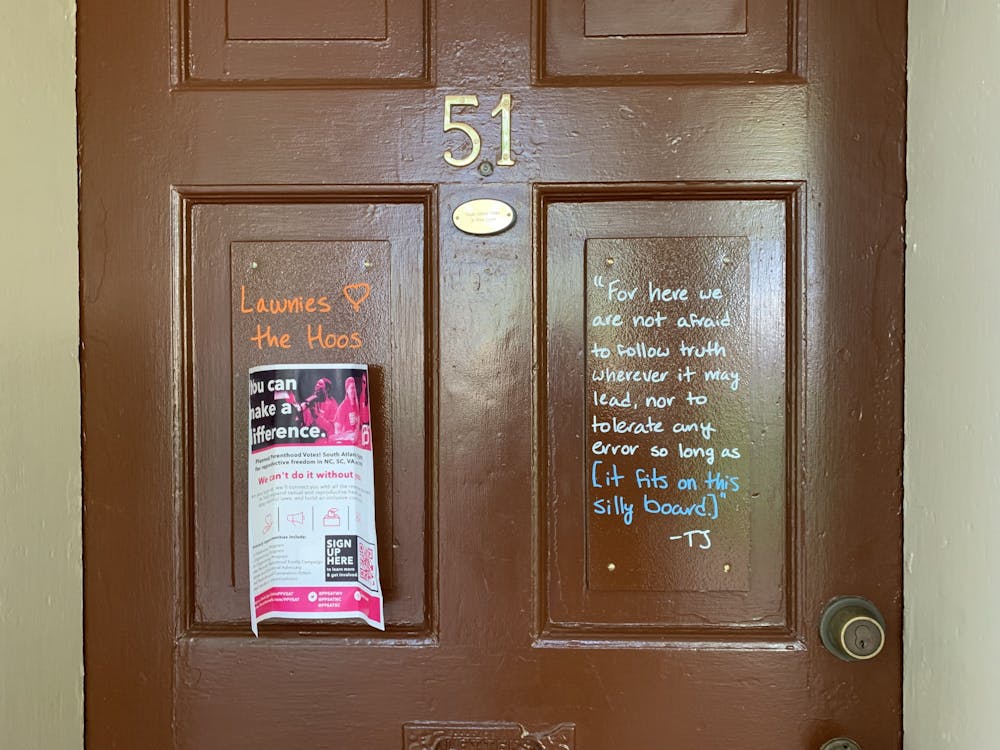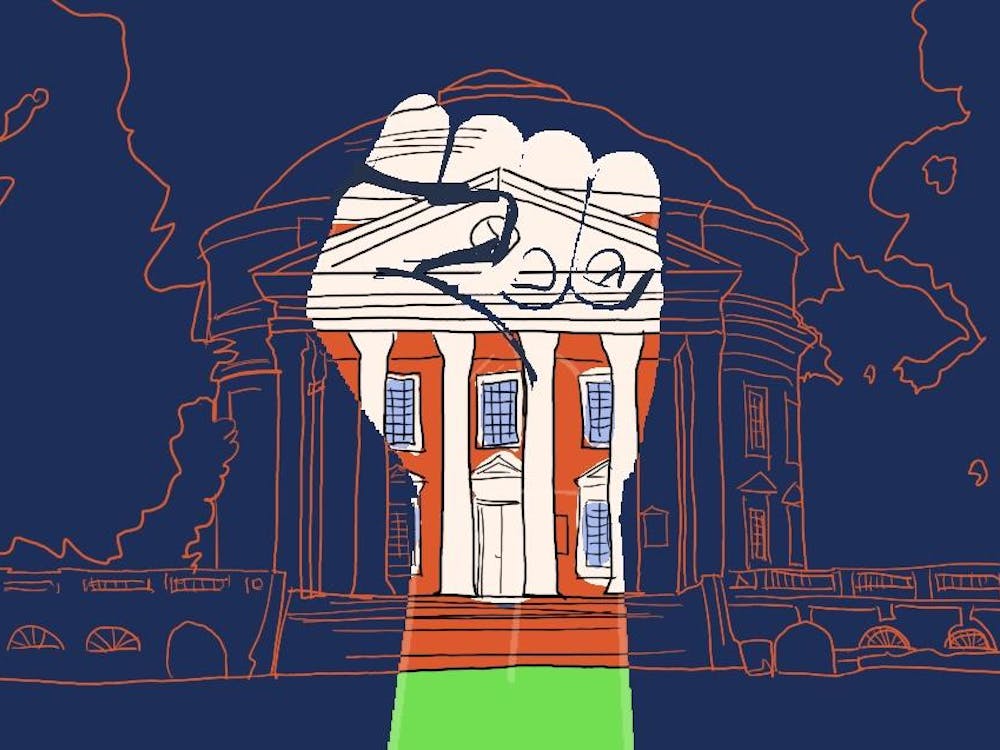中文版请点击此处 // Lea en español
Over the past year, Lawn room doors have been a site of heavy tension on Grounds. Last fall, several Lawn residents put up signs criticizing the University. Since then, the University has imposed stringent regulations. Now, Lawn residents are limited to signage within the four corners of the boards on their Lawn doors, which is sometimes smaller than the size of a standard piece of paper. These restrictions were defensively adopted in response to a series of highly publicized incidents and are a direct threat to students’ right to free speech and free expression. The restrictions introduced have the potential to deter students from criticizing the University at all, for fear of increased sanctioning. For this reason, the administration must reconsider the current excessive Lawn signage restrictions.
Historically, Lawn room doors have been a place of community and sharing. Residents put up signs as a way of expressing their passions and sharing them with the University community and anyone on Grounds. We cannot forget that Lawn residents are supposed to represent a carefully curated reflection of diverse experiences and values across the University, chosen for their holistic involvement in the Charlottesville and University communities. Given this, the Lawn rooms are intended to serve as a forum for exchange between the University and by extension the wider Charlottesville community at large. Therefore, the benefits of open communication and expression should not be understated. However, it is naive and condescending to think that Lawn room signs are intended to solely promote positive community building. They are also a prominent platform for publicizing students’ criticisms.
In the past week, Housing and Residence Life followed through on enforcing the new restrictions. Fourth-year College student Emma Camp was required to remove her sign — which was nearly the size of the door itself and included the full text of the First Amendment. Another Lawn resident was directed to trim his 8.5 x 11” Planned Parenthood poster by one inch to fit on his message board — a space smaller than a standard sheet of printer paper. These two instances capture the absurdity of these new rules. Neither sign had a “threatening nature” — the alleged reason for previous Lawn sign removal. Rather, both signs were opportunities for the residents to speak out about important topics.
Unfortunately, these restrictions are even more questionable when one realizes that they have all come about in response to speech by Black and Brown students. The original signs that began this conflict are now infamous. The first critical sign condemned white supremacy with the phrases “F—k UVA,” “UVA Operating Costs: KKKops, Genocide Slavery, Disability, Black and Brown Life.” The next — which the University forcibly removed — displayed an image of a flaming Rotunda draped with a white hood, resembling that of the Klu Klux Klan, with a grim reaper holding a scythe and police belt with the initials “UPD.” Both signs were clear protests of white supremacy, police brutality and institutional racism at the University. Ultimately, the University removed the second sign under the pretense that it “advocate[d] physical violence, and [could] spur it” — a blatant overstep by the administration on what was clearly a form of symbolic speech. Even if the University’s ruling were true, the same characterization cannot be made of the signs taken down this semester. The University has baselessly inducted a new wave of content and size restrictions on signs in response to Black and Brown students protesting discrimination.
While not explicit, the University’s decisions have a clear undertone of content restrictions. The University has taken action restricting lawn signage in response to content they did not approve of. The restrictions are hypocritical. Just last June, the Board of Visitors endorsed a statement of the University’s commitment to free speech, “unequivocally” affirming its dedication. In the past year alone, the University dropped from sixth to 22nd place on the Foundation for Individual Rights in Education’s College Free Speech Rankings list.
We must decide what type of community we want on Grounds. As students, we should continue to demand creative avenues of expression from the University. Lawn room signs — large, bold and expressive — are a part of what makes the University so special, giving fourth-year students a unique platform and the privilege to address anyone who walks past their room. Regardless of whether one agrees with the content of the message, the University should not limit this form of speech. Indeed, last semester President Jim Ryan echoed this sentiment, writing, “I believe it is a matter of principle and the obligation, especially of universities, to protect speech even when it is offensive, and to stand firm against pressure to ignore the Constitution.” He went on to add that “[u]pholding fundamental principles against temptation or pressure to contravene them can be a hard thing to do, but I believe it is the right thing to do.” Today these ill-advised restrictions seem almost to be antithetical to the very position President Ryan took. Apparently the timeline for “standing firm” expires after 12 months.
The University must reduce Lawn room sign restrictions. Free speech is a critical component of education at the University and any liberal arts campus. While there are indeed practical safety limitations to impose on Lawn room signs, the current restrictions are excessive and ridiculous. Lawn residents have a particularly unique platform to reach those in the University community — the University should not limit their free speech.
The Cavalier Daily Editorial Board is composed of the Executive Editor, the Editor-in-Chief, the two Opinion Editors, their Senior Associate and an Opinion Columnist. The board can be reached at eb@cavalierdaily.com.







